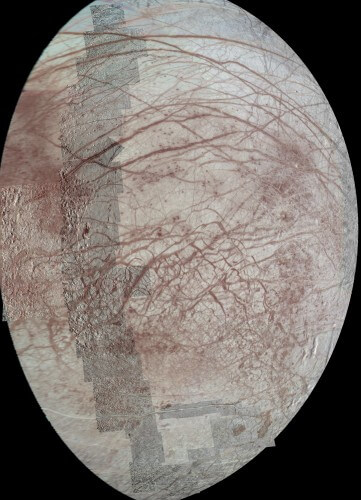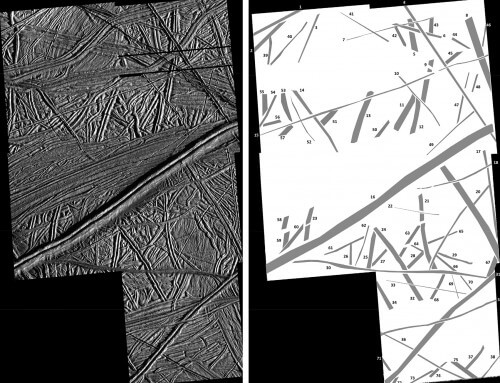By analyzing the cracks that span the icy surface of the moon Europa, NASA scientists discovered evidence that this moon of Jupiter rotated on a tilted axis for some time. This tendency could have affected the calculation of how long the ice sheet existed, how much heat was generated by the tides in the underground ocean and even how long the liquid ocean existed.

By analyzing the cracks that span the icy surface of the moon Europa, NASA scientists discovered evidence that this moon of Jupiter rotated on a tilted axis for some time. This tendency could have affected the calculation of how long the ice sheet existed, how much heat was generated by the tides in the underground ocean and even how long the liquid ocean existed.
One of the mysteries of "Europe" is why the direction of the cracks changed over time. It seems that a small tilt in the axis of rotation at some time in the past can explain most of what we see." says Alyssa Roden, a postdoctoral fellow at Oak Ridge University who works at NASA's Goddard Space Flight Center in Maryland. She is the lead researcher in an article that will appear in the September-October issue of the journal Icarus.
The network of transverse cracks of "Europa" serves as evidence of the pressures caused by the tidal waves in the global ocean of the moon. These tidal waves occur because "Europa" orbits Jupiter in a slightly elliptical orbit. When "Europe" approaches Jupiter, the moon stretches a little like a rubber band, and the ocean surface rises by about 30 meters - like the deadly tsunami of 2004 in the Indian Ocean. However, it occurs on a body whose diameter is only a quarter of that of the Earth. When "Europa" moves away from Jupiter, it relaxes again and becomes a round sphere.
The ice sheet of "Europe" must stretch to compensate for these changes, but when the pressure is too great it cracks. The puzzling part is why the cracks point in different directions over time, even though the same side of "Europe" is always facing Jupiter?
The accepted explanation is that the icy outer shell of "Europa" rotates slightly faster than the duration of the moon's orbit around Jupiter. If this desynchronization did occur, that part of the ice crust would not always face Jupiter.
Roden and her colleague Terry Harford put this hypothesis to the test using images taken by NASA's Galileo spacecraft during its eight years of operation beginning in 1995. "Galileo caused paradigm changes in our understanding of "Europa", and one of them was the phenomenon of the unsynchronized spin" says Claudia Alexander from NASA's Jet Propulsion Laboratory (JPL) in California, who was the project manager at the end of the Galileo mission.
Roden and Hartford compared the crack patterns in large areas near the equator of "Europe" to make predictions based on three different hypotheses. The first series of predictions was based on the rotation of the ice sheet. The second estimate is that "Europe" rotated on an inclined axis, which in turn caused the direction of the poles to change over time. This phenomenon, known as precession, looks like what happens when a spinning toy starts to slow down and oscillate. The third hypothesis was that the cracks are located in random directions.

The researchers performed best when they estimated that the precession was occurring, and it was caused by a tilt of about one degree, combined with some random cracks, Roden says. The hypothesis of an exit from Schenron surprisingly failed. The results satisfy Richard Greenberg, a professor at the University of Arizona who proposed the idea of spinning out of sync. "By extracting insight from Galileo's data, this work refines and improves our understanding of the unusual geology of "Europe"" says Greenberg, who was the supervisor of the two during different periods of their studies.
"The existence of the inclination does not rule out the possibility of going out of sync," say Roden and Greenberg, but it supports the hypothesis that the cracks of "Europe" may be younger than we previously thought. This is because the direction of rotation of the poles changes by several degrees per day, and it completes one precession period within a few months. On the other hand, with the leading explanation, a complete rotation of the ice sheet would require about a quarter of a million years. In any case, it will take several laps to explain the crack pattern.

One response
It's a network of roads and not cracks
NASA does not want you to know that there is an advanced civilization on this moon